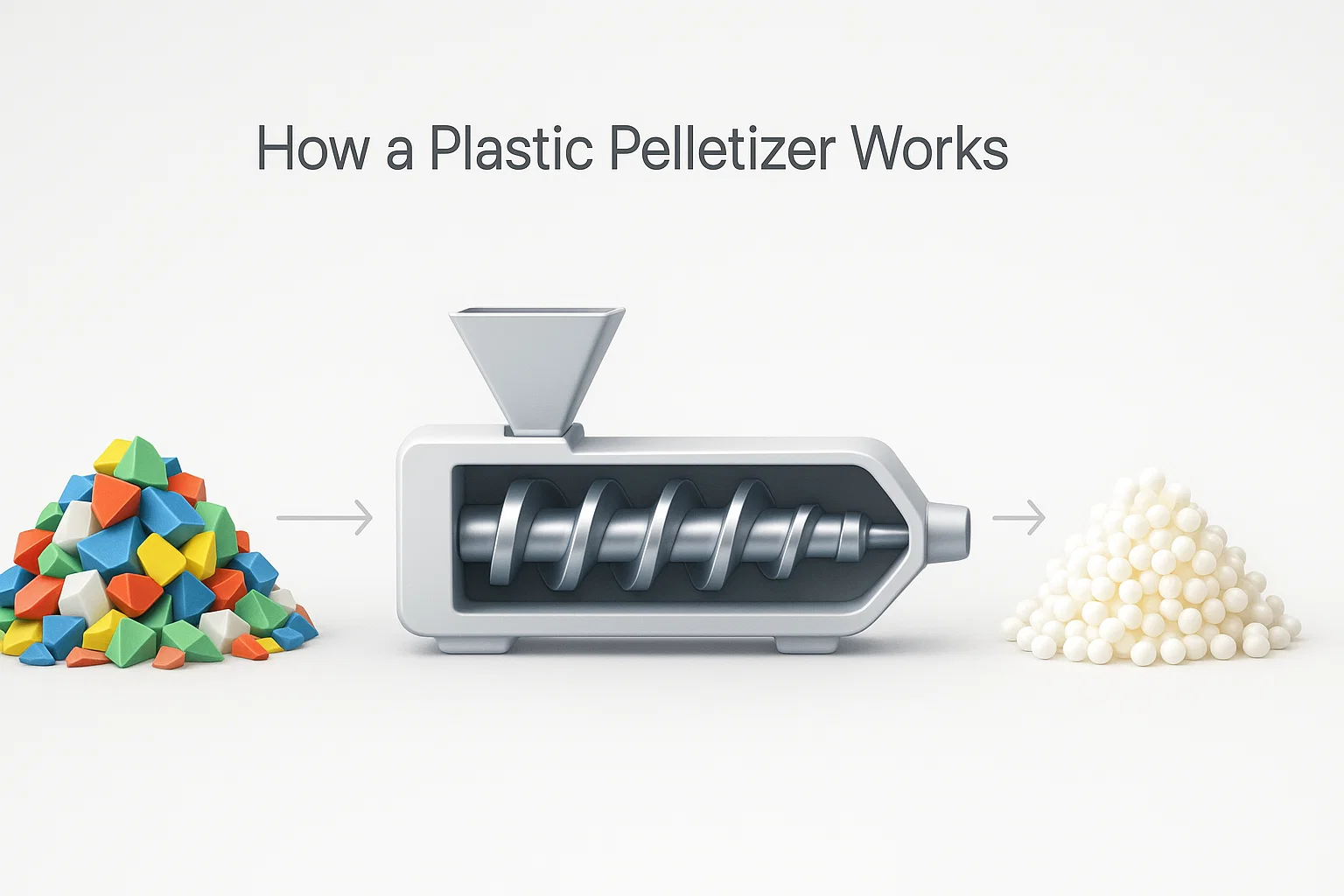Desbloqueando o Valor do Resíduo de Plástico: A Função Central de um Pelotizador
No mundo do reciclagem industrial, transformar resíduos plásticos volumosos e de baixo valor em matérias-primas uniformes e de alto valor é o objetivo final. No coração dessa transformação está um equipamento crítico: o pelotizador avançado. Para profissionais de reciclagem e gerentes de instalações, entender os detalhes funcionais desse equipamento não é apenas uma questão de curiosidade técnica; é fundamental para otimizar operações, garantir a qualidade do produto final e maximizar a lucratividade.
A pelotizador avançado, ou linha de pelotização, é um sistema integrado projetado para derreter, filtrar e cortar resíduos plásticos limpos em pequenos grânulos consistentes conhecidos como pelotas ou nurdles. Essas pelotas são o sangue da economia circular, prontas para serem vendidas e usadas na fabricação de novos produtos.
Na Rumtoo, acreditamos que um comprador informado é um parceiro bem-sucedido. Este guia o guiará através de todo o processo de pelotização, desde a entrada de matéria-prima até a pelota final, pronta para venda.
Anatomia de uma Linha de Pelotização de Plástico: Componentes Chave
Antes de mergulhar no processo, é essencial entender os principais componentes que funcionam em harmonia. Uma linha de pelotização completa é mais do que um único equipamento; é uma sinfonia de módulos integrados.
- Sistema de Alimentação: Introduz o resíduo plástico bruto e limpo (flocos ou filme) no sistema a uma taxa controlada.
- Extrusor: O motor da linha. Consiste em um cilindro aquecido contendo um ou dois rolos rotativos. Sua função é derreter, misturar e construir pressão.
- Sistema de Filtragem de Derretimento: Um trocador de tela que remove quaisquer contaminantes sólidos remanescentes (como metais, papel ou outros plásticos) do polímero derretido.
- Zona de Degasificação (Esvaziamento): Válvulas no cilindro do extrusor que permitem a fuga de umidade e gases voláteis contidos, o que é crucial para a produção de pelotas de alta qualidade, livres de vazios.
- Cabeça de Pelotização (Die): Placa especializada com inúmeras pequenas furos através dos quais o plástico derretido é forçado, formando fios espaguete ou "macarrão."
- Sistema de Corte: A unidade que corta os fios de plástico em grânulos uniformes. O tipo de sistema de corte é um diferenciador principal entre os modelos de granulador.
- Sistema de Resfriamento e Transporte: Um sistema, geralmente usando água ou ar, para resfriar e solidificar rapidamente os grânulos recém-cortados.
- Secagem e Armazenamento: Uma máquina de desaguamento ou secador centrífugo remove a umidade residual antes dos grânulos serem transportados para um silo de armazenamento, pronto para embalagem.
O Processo de Granulação Passo a Passo: Do Escama ao Granulo
Entender a sequência de operações ajuda a esclarecer como um pelotizador avançado alcança sua transformação notável.
Passo 1: Alimentação e Transporte de Material
O processo começa com resíduos de plástico preparados — geralmente lavados e triturados em pequenos escamas. Um transportador de espiral ou alimentador de correia transporta este material de um funil para dentro do extrusor. Uma alimentação consistente e uniforme é crucial para evitar flutuações no processo e garantir uma saída estável.
Passo 2: Derretimento, Mistura e Homogenização (O Estágio de Extrusão)
Uma vez dentro do cilindro do extrusor, as escamas de plástico são empurradas para frente por uma espiral grande e rotativa (ou espirais duplas). Este estágio realiza três coisas simultaneamente:
- Transporte: O material se move do gargalo de alimentação até o bico.
- Derretimento: Uma combinação de fricção da rotação do espiral e elementos de aquecimento externos ao longo do cilindro derrete o plástico em um estado viscoso e fundido.
- Mistura e Homogenização: O design do espiral mistura completamente o polímero fundido, garantindo uma temperatura e viscosidade consistentes ao longo. Qualquer corante ou aditivo é misturado neste estágio.
Passo 3: Filtragem e Desgaseificação
À medida que a mistura homogenizada se aproxima do final do extrusor, é forçada através de um sistema de filtração de mistura a alta pressão. Este trocador de tela captura impurezas físicas, garantindo que o produto final seja puro.
Simultaneamente, orifícios de ventilação assistidos por vácuo especialmente projetados ao longo do cilindro extraem qualquer ar, umidade e compostos orgânicos voláteis (VOCs) retidos. Uma desgaseificação eficaz é vital para evitar grânulos porosos e frágeis e é especialmente importante ao processar filmes impressos ou materiais ligeiramente úmidos.
Passo 4: Formação e Corte de Pelotas
É aqui que a magia acontece. O plástico limpo e pressurizado é extrudido através da cabeça de模具, formando fios contínuos. Esses fios são então imediatamente cortados em pelotas. O método de corte define o tipo de sistema de pelotização.
Gráfico: Comparação de Sistemas de Pelotização
Para compradores industriais, a escolha da tecnologia de corte adequada é uma decisão crítica baseada no tipo de material, necessidades de capacidade de produção e preferências operacionais.
| Recursos | Pelotização de Fio (Corte Frio) | Pelotização com Anel d'Água (Face de Moldo Quente) | Pelotização Submersa (Face de Moldo Quente) |
| Processo | Os fios são resfriados em um banho de água, então cortados por um rotor. | Lâminas giram na face de模具, cortando pelotas que são jogadas em um anel de água. | Lâminas cortam pelotas na face de模具 completamente submersa em uma câmara de água. |
| Materiais Apropriados | Maiorias das termoplásticas (PE, PP, PS). Ideal para plásticos recheados ou reforçados. | Poliolefínicos (PE, PP), Estireno. Excelente para materiais com MFI mais baixo. | Ampa gama de polímeros incluindo PET, PA, TPU e materiais sensíveis à oxidação. |
| Forma de Pelotas | Cilíndrica | Sferica / Formada de feijão | Sferica / Formada uniformemente |
| Custos Operacionais | Investimento inicial e manutenção mais baixos. | Investimento inicial moderado. Operação eficiente. | Investimento inicial mais alto e complexidade. |
| Automatização & Trabalho | Mais intensivo em mão-de-obra (início da fita). | Altamente automatizado. | Totalmente automatizado, processo contínuo. |
| Rumtoo Insight | Uma escolha robusta e versátil para muitas aplicações de reciclagem padrão. | O método mais popular para reciclagem em grande volume de poliolefins devido à sua eficiência. | A escolha premium para pelotas de alta qualidade e uniformidade perfeita, bem como para materiais difíceis. |
Escolhendo o Pelotizador de Plástico Ideal para Sua Operação
O ideal pelotizador avançado depende entirely de suas necessidades específicas. Considere os seguintes fatores:
- Tipo de Plástico: Você está processando plásticos rígidos (HDPE, PP) ou filmes macios (LDPE, LLDPE)? O índice de fluxo de derretimento (MFI) e as características do material determinam o melhor extrusor e design de corte.
- Nível de Contaminação: A natureza e a quantidade de contaminação determinarão a complexidade dos sistemas de filtração e lavagem necessários no processo anterior.
- Requisitos de Capacidade: A capacidade desejada em kg/h ou toneladas/dia é um fator primário na dimensionamento da linha completa.
- Espaço Operacional: Limitações de espaço podem influenciar a escolha entre um sistema compacto de anel d'água e uma linha de pelotização de fio mais longa.
Para operações focadas em plásticos macios como filmes de PE e filmes agrícolas, uma máquina especificamente projetada para este tipo de entrada é crucial. Por exemplo, se você fornece principalmente tais materiais, um sistema como o nosso Máquina de Pelotização de Plástico Suave com单一螺杆 É projetado com um aglomerador/compactor para densificar o material leve antes de entrar no extrusor, garantindo alimentação estável e alta produção.
Perguntas Frequentes (FAQ)
1. Qual é a principal diferença entre um extrusor de espiral única e um extrusor de espiral dupla em um pelotizador?
Um extrusor de espiral única é um veículo robusto e econômico ideal para reprocessamento de resíduos de termoplásticos homogêneos, pré-limpados. Um extrusor de espiral dupla oferece capacidades superiores de mistura, compounding e degassing, tornando-o melhor para misturar diferentes polímeros, incorporar altas quantidades de aditivos ou processar materiais difíceis de derreter ou que requerem venting intensivo.
2. Quanto de manutenção um pelotizador de plástico requer?
A manutenção rotineira é essencial para a longevidade e desempenho. Isso inclui verificações diárias de lubrificação e elementos de aquecimento, troca regular de telas de filtro e inspeção e substituição periódica de peças de alta usura como espirais, cilindros e lâminas de corte. A Rumtoo oferece calendários de manutenção detalhados e suporte para toda nossa maquinaria.
3. Um pelotizador pode lidar com todos os tipos de plástico?
Embora alguns pelotizadores sejam versáteis, nenhuma máquina é otimizada para todos os tipos de plástico. Uma máquina projetada para PET terá uma geometria de espiral e requisitos de secagem diferentes de uma projetada para filme PE macio. É crucial escolher um pelotizador otimizado para sua matéria-prima primária para garantir a eficiência máxima e a qualidade dos pelotizadores.
4. Qual é o ROI típico de uma linha de pelotização de plástico?
O retorno sobre investimento (ROI) depende de fatores como o custo da sua matéria-prima de resíduos de plástico, o preço de mercado dos pelotizadores reciclados, seus custos operacionais (mão de obra, energia) e a capacidade de produção da máquina. Com uma máquina confiável e eficiente de um fornecedor confiável como a Rumtoo, muitos de nossos clientes veem um ROI forte dentro de 18-36 meses.
5. Como a Rumtoo suporta clientes após a venda?
Nosso compromisso se estende além da compra. A Rumtoo oferece suporte abrangente, incluindo supervisão de instalação, treinamento de operadores, fornecimento confiável de peças de reposição e assistência técnica remota para garantir que seu pelotizador de plástico operate em seu melhor desempenho por muitos anos.
Conclusão: Seu Parceiro em Reciclagem Avançada
A pelotizador avançado é mais do que uma máquina; é o motor da sua operação de reciclagem. Ao converter fluxos de resíduos desafiadores em uma commodity valiosa, fecha o ciclo da produção de plástico. Entender sua mecânica, desde o poderoso processo de extrusão até a precisão do sistema de corte, capacita você a fazer um investimento estratégico que renderá dividendos em qualidade, eficiência e lucratividade.
Pronto para explorar a solução de pelotização certa para sua instalação? A equipe especialista da Rumtoo está aqui para ajudá-lo a navegar pelas opções e projetar um sistema adaptado às suas necessidades únicas.
Entre em contato conosco hoje para discutir seu projeto ou explorar nossa ampla gama de maquinaria avançada de reciclagem de plástico.

